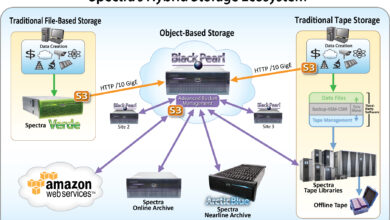What is the Hybrid Cloud: Revolutionizing the Business Landscape

In today’s rapidly evolving digital age, businesses are constantly seeking innovative solutions to optimize their operations and increase efficiency. One such solution that has gained significant traction is the hybrid cloud. But what exactly is the hybrid cloud, and why is it crucial for businesses to embrace this technology?
Contents
- A. Definition of Hybrid Cloud
- B. Importance of Hybrid Cloud in Today’s Business Landscape
- C. Brief Overview of Hybrid Cloud Architecture
- Understanding Hybrid Cloud
- Advantages of Hybrid Cloud
- Use Cases and Examples of Hybrid Cloud Adoption
- Challenges and Considerations in Implementing Hybrid Cloud
- Future Trends and Conclusion
A. Definition of Hybrid Cloud

The hybrid cloud can be best described as a combination of both private and public clouds, offering a flexible and scalable solution for businesses. It allows organizations to leverage the benefits of both cloud models, seamlessly integrating their on-premises infrastructure with the public cloud. This amalgamation enables businesses to enjoy the best of both worlds, capitalizing on the security and control provided by private clouds while leveraging the cost-effectiveness and scalability of public clouds.
B. Importance of Hybrid Cloud in Today’s Business Landscape
In a world where data is the new gold, businesses need to adapt swiftly to stay competitive. The hybrid cloud has emerged as a game-changer, enabling organizations to optimize their IT infrastructure and seize new opportunities. By leveraging the hybrid cloud, businesses can efficiently manage their data, applications, and workloads, ensuring seamless connectivity and collaboration across different environments. This technology empowers enterprises to achieve operational agility, enabling faster time-to-market, enhanced customer experiences, and improved business outcomes.
C. Brief Overview of Hybrid Cloud Architecture
To better comprehend the hybrid cloud, it is essential to understand its architecture. Generally, the hybrid cloud architecture consists of two primary components: the private cloud and the public cloud. The private cloud, as the name suggests, is a dedicated infrastructure that is solely owned and operated by the business itself. It provides enhanced security, control, and customization options. On the other hand, the public cloud is hosted by external service providers, offering scalability, cost-effectiveness, and on-demand resources. The hybrid cloud leverages a robust network connection to seamlessly integrate these two environments, ensuring a cohesive and efficient infrastructure.
As businesses strive to stay ahead in the digital era, understanding and embracing the hybrid cloud has become imperative. In the subsequent sections, we will delve deeper into the advantages, use cases, challenges, and future trends surrounding the hybrid cloud. So, let’s embark on this transformative journey and unlock the true potential of the hybrid cloud!
Understanding Hybrid Cloud
In order to grasp the concept of hybrid cloud fully, it is essential to have a clear understanding of its constituent elements – the public cloud, private cloud, and the integration that brings them together.
A. Definition and Explanation of Public Cloud
The public cloud is a cloud computing model where resources, such as storage and applications, are provided by third-party service providers over the internet. These services are accessible to multiple organizations or individuals, making it a shared infrastructure. Public cloud offerings typically include Infrastructure as a Service (IaaS), Platform as a Service (PaaS), and Software as a Service (SaaS). This cloud model provides scalability, cost-effectiveness, and the ability to offload infrastructure management to the service provider.
B. Definition and Explanation of Private Cloud
On the other hand, the private cloud refers to a dedicated cloud infrastructure exclusively owned and operated by a single organization. It can be located on-premises or hosted by a third-party provider. Private clouds offer enhanced security, control, and customization options, making them ideal for businesses with stringent data privacy and compliance requirements. Organizations can tailor their private cloud environment to meet their specific needs, ensuring optimal performance and reliability.
C. Integration and Benefits of Hybrid Cloud
The true power of hybrid cloud lies in its ability to seamlessly integrate the public and private cloud environments. This integration enables organizations to leverage the unique benefits of each cloud model while addressing their specific business requirements. By adopting a hybrid cloud approach, businesses can achieve greater flexibility, scalability, and cost optimization. They can choose to keep sensitive data and critical applications on the private cloud while utilizing the public cloud for non-sensitive workloads, seasonal peaks, or bursty traffic. The hybrid cloud architecture empowers organizations to design a tailored solution that maximizes efficiency and aligns with their unique business needs.
In the upcoming sections, we will explore the advantages that hybrid cloud brings to the table. From scalability and cost-effectiveness to enhanced security and data protection, the hybrid cloud offers a plethora of benefits that empower organizations to thrive in the digital landscape. So, let’s dive deeper into the reasons why businesses are embracing hybrid cloud solutions.
Advantages of Hybrid Cloud
In the ever-evolving digital landscape, businesses are constantly seeking ways to optimize their operations and gain a competitive edge. The hybrid cloud offers a multitude of advantages that make it an attractive choice for organizations looking to enhance their IT infrastructure. Let’s explore the key benefits of embracing the hybrid cloud:
A. Scalability and Flexibility
One of the primary advantages of the hybrid cloud is its scalability and flexibility. By leveraging the hybrid cloud model, businesses can seamlessly scale their resources up or down based on their fluctuating demands. During periods of high traffic or increased workloads, organizations can tap into the resources offered by the public cloud, ensuring that they meet the demands without any disruptions. Conversely, during quieter periods, they can scale down their resources, optimizing costs and improving efficiency. This flexibility allows businesses to adapt swiftly to changing market conditions and seize new opportunities without the need for significant infrastructure investments.
B. Cost-effectiveness
Cost-effectiveness is another significant advantage of the hybrid cloud. By integrating both private and public clouds, businesses can optimize their IT spending. They can leverage the cost-efficient public cloud for non-sensitive data or workloads that require high scalability, while utilizing the private cloud for critical applications and sensitive data that require enhanced security and compliance. This hybrid approach enables businesses to strike a balance between cost and security, optimizing their IT budget and reducing unnecessary expenses. Additionally, the pay-as-you-go model of the public cloud ensures that businesses only pay for the resources they actually use, further enhancing cost-effectiveness.
C. Enhanced Security and Data Protection
Security and data protection are paramount concerns for businesses across industries. The hybrid cloud provides an ideal solution by combining the security measures of a private cloud with the advanced security features offered by reputable public cloud providers. Organizations can store their critical and sensitive data on the private cloud, ensuring complete control and adherence to regulatory requirements. Simultaneously, they can leverage the robust security infrastructure and expertise of public cloud providers to safeguard their data and applications. This hybrid approach provides businesses with a comprehensive security framework, mitigating risks and protecting valuable assets.
By harnessing the advantages of scalability, cost-effectiveness, and enhanced security, the hybrid cloud empowers businesses to optimize their operations, drive innovation, and achieve sustainable growth. In the following sections, we will explore real-world use cases, challenges, and considerations surrounding the implementation of hybrid cloud solutions. So, let’s continue on this transformative journey and discover the immense potential of the hybrid cloud!
Use Cases and Examples of Hybrid Cloud Adoption
The adoption of hybrid cloud solutions has witnessed widespread acceptance across various sectors. Let’s explore some key use cases and real-world examples that demonstrate the benefits of hybrid cloud implementation.
A. Hybrid Cloud Implementation in Enterprise Organizations
Large-scale enterprises often have diverse and complex IT infrastructure requirements. Hybrid cloud adoption offers a viable solution to address these challenges. By integrating their existing on-premises infrastructure with the public cloud, enterprises can optimize resource allocation, enhance scalability, and improve overall operational efficiency.
For example, a multinational corporation may utilize a hybrid cloud approach to store sensitive customer data in their private cloud while leveraging the public cloud for non-sensitive workloads such as email services or collaboration tools. This strategic implementation allows businesses to maintain control over critical data while simultaneously benefiting from the agility and cost effectiveness offered by the public cloud.
B. Hybrid Cloud Adoption in Small and Medium-sized Businesses
Hybrid cloud adoption is not limited to large enterprises. Small and medium-sized businesses (SMBs) can also leverage this technology to accelerate growth and overcome resource constraints. By implementing a hybrid cloud strategy, SMBs can optimize their IT infrastructure, reduce costs, and enhance operational efficiency without compromising on security or performance.
For instance, a startup with limited resources may choose to host its business-critical applications and data on a private cloud while utilizing the public cloud for non-sensitive tasks like web hosting or development environments. This approach allows the startup to scale their operations seamlessly, adapt to changing demands, and allocate resources effectively.
C. Success Stories and Case Studies
Numerous success stories and case studies highlight the tangible benefits achieved through hybrid cloud adoption. For instance, Netflix, a leading streaming service provider, utilizes a hybrid cloud model to deliver uninterrupted content to millions of users worldwide. By combining their private infrastructure with public cloud services, Netflix ensures high availability, scalability, and cost optimization.
Another remarkable example is the healthcare industry, where hybrid cloud adoption has enabled secure storage and sharing of critical patient data while complying with stringent privacy regulations. Healthcare organizations can leverage the flexibility of the hybrid cloud to seamlessly integrate on-premises systems with cloud-based applications, ultimately improving patient care and streamlining operations.
These use cases and success stories underscore the transformative potential of hybrid cloud adoption across diverse industries and organizations, regardless of their size. By harnessing the power of this technology, businesses can unlock new opportunities, drive innovation, and stay ahead in the ever-evolving digital landscape.
Challenges and Considerations in Implementing Hybrid Cloud
Implementing a hybrid cloud infrastructure undoubtedly offers numerous benefits, but it also comes with its fair share of challenges. In this section, we will explore some of the key challenges and considerations that businesses need to address when adopting a hybrid cloud model.
A. Integration and Compatibility Issues
Integrating and ensuring compatibility between different cloud environments can be a complex task. Organizations often face challenges in seamlessly connecting their private and public clouds, especially when dealing with diverse technologies, protocols, and platforms. Compatibility issues can arise due to differences in APIs, data formats, and security protocols. Therefore, it is crucial for businesses to carefully plan and implement robust integration strategies to ensure smooth and efficient communication between their hybrid cloud components.
B. Data Migration and Management
Migrating and managing data effectively is another critical consideration for businesses implementing a hybrid cloud. Transferring vast amounts of data between on-premises infrastructure and the public cloud can be time-consuming and resource-intensive. Organizations must evaluate their data transfer methods, ensuring efficient and secure migration processes. Additionally, managing data across multiple environments requires proper governance, data protection, and backup strategies. Implementing robust data management practices and leveraging appropriate tools can help businesses overcome these challenges and ensure the seamless flow of data within their hybrid cloud ecosystem.
C. Compliance and Regulatory Concerns
Compliance and regulatory requirements play a vital role in today’s data-driven business landscape. When adopting a hybrid cloud model, organizations must ensure that their data and applications comply with relevant industry standards and regulations. Different cloud environments may have varying compliance frameworks, making it essential for businesses to carefully assess the compliance capabilities of their hybrid cloud providers. Additionally, data sovereignty and privacy regulations can pose challenges when dealing with sensitive information, requiring businesses to implement proper encryption, access controls, and data residency measures to comply with local laws and regulations.
By proactively addressing these challenges and considerations, businesses can mitigate potential risks and maximize the benefits of their hybrid cloud implementation. In the next section, we will explore real-world use cases and examples of how organizations have successfully adopted and leveraged the hybrid cloud to drive innovation and growth.
Future Trends and Conclusion
As technology continues to advance at an unprecedented pace, the future of the hybrid cloud appears brighter than ever. Let’s explore some of the trends that will shape the hybrid cloud landscape and conclude our discussion on this game-changing technology.
A. Predictions for the Future of Hybrid Cloud
The hybrid cloud is poised to witness significant growth in the coming years. According to industry experts, the hybrid cloud market is projected to expand exponentially, driven by factors such as the increasing need for data security, regulatory compliance, and the rising demand for seamless integration between on-premises and cloud environments. As businesses continue to recognize the benefits of the hybrid cloud, the technology will evolve to cater to their evolving needs, ensuring enhanced performance, scalability, and efficiency.
B. Importance of Hybrid Cloud in Digital Transformation
In the era of digital transformation, the hybrid cloud is a vital enabler for businesses looking to scale and innovate. By seamlessly integrating on-premises infrastructure with the public cloud, organizations can effectively leverage emerging technologies such as artificial intelligence, machine learning, and big data analytics. The hybrid cloud provides the necessary foundation for businesses to embrace these transformative technologies, gain actionable insights from data, and drive innovation across all facets of their operations.
C. Final Thoughts and Recommendations for Businesses Considering Hybrid Cloud Adoption
In conclusion, the hybrid cloud has emerged as a game-changing technology that empowers businesses to unlock new possibilities and fuel growth. Its unique ability to combine the best features of private and public clouds offers unparalleled flexibility, scalability, and security. As more organizations embrace digital transformation and seek ways to optimize their IT infrastructure, adopting the hybrid cloud becomes a strategic imperative.
For businesses considering hybrid cloud adoption, it is crucial to thoroughly evaluate their specific requirements, including data security, compliance, scalability, and cost-efficiency. Engaging with experienced cloud service providers and consultants can provide valuable insights and guidance throughout the adoption journey. By embracing the hybrid cloud, businesses can future-proof their operations, gain a competitive edge, and propel their success in the dynamic digital landscape.
At Cloud.tapchiai.net, we understand the significance of the hybrid cloud in driving innovation and business growth. As a leading provider of cloud solutions, we are committed to empowering organizations with seamless and secure hybrid cloud adoption. Contact us today to embark on your hybrid cloud journey and unlock the true potential of your business.
Remember, the hybrid cloud is not just a technology; it’s a gateway to endless possibilities. Embrace it, and witness your business soar to new heights!
Conclusion: So above is the What is the Hybrid Cloud: Revolutionizing the Business Landscape article. Hopefully with this article you can help you in life, always follow and read our good articles on the website: Cloud.tapchiai.net




